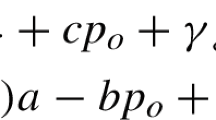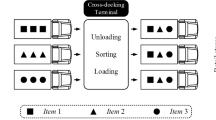Abstract
This study addresses a capacity-trading problem for semiconductor foundry manufacturing. Because of the geographic proximity of fabs, a semiconductor foundry with insufficient capacity can purchase capacity from partner fabs as a short-term solution if a capacity-trading agreement has been established. Capacity-trading with partners could be considered as a source for enhancing competitiveness of factory clusters. This investigation presents several linear programming and mixed integer liner programming formulations for establishing the capacity-trading platform. This research was implemented via a computer program with real factory data using mathematical programming formulations capable of rapidly generating reliable solutions. The proposed trading model involves three modules. The first module, a factory scheduling module, allows planners to make capacity outsourcing decisions. Secondly, a tradable capacity economic analysis module identifies capacity requirements and evaluates tradable capacity. Thirdly, optimal resource allocation is obtained using a combinatorial auction module. This research makes two main contributions. A capacity-trading model is to integrate several mathematical programming modules in capacity auction. In addition, this model is presented for short-term flexibility of capacity expansion and combinatorial purchase strategies are designed to solve the large-scale problem.
Similar content being viewed by others
References
Argoneto P, Renna P (2009) A game theoretic coordination for trading capacity in multisite factory environment. Int J Adv Manuf Technol 47:1241–1252
Benavides DL, Duley JR, Johnson BE (1999) As good as it gets: optimal fab design and deployment. IEEE Trans Semicond Manuf 12(3):281–287
Bermon S, Hood SJ (1999) Capacity optimization planning system. Interfaces 29(5):31–50
Chang SC, Hsieh MM, Chen CW (2007) Reverse auction-based job assignment among foundry fabs. Int J Prod Res 45(3):653–673
Chen JC, Chen CW, Lin CJ, Rau H (2005) Capacity planning with capability for multiple semiconductor manufacturing fabs. Comput Ind Eng 48:709–7326
Chou YC, Hong IH (2000) A Methodology for product mix planning in semiconductor foundry manufacturing. IEEE Trans Semicond Manuf 13(3):278–285
Chou YC, Wu CS (2002) Economic analysis and optimization of tool portfolio in semiconductor manufacturing. IEEE Trans Semicond Manuf 15(4):447–453
Chou YC, You RC (2001) A resource portfolio planning methodology for semiconductor wafer manufacturing. Int J Adv Manuf Technol 18:12–19
Christie RME, Wu SD (2002) Semiconductor capacity planning: stochastic modeling and computational studies. IIE Trans 34(2):131–143
Chung SH, Lee AHI, Pearn WL (2003) Product mix optimization for semiconductor manufacturing based on AHP and ANP analysis. Int J Adv Manuf Technol 25:1144–1156
Chung SH, Lee AHI, Pearn WL (2005) Analytic network process (ANP) approach for product mix planning in semiconductor fabricator. Int J Prod Econ 96:15–36
DeBoo S (2000) Block cross processing: an innovative approach to constraint management. In: Proceedings of International Symposium on Semiconductor Manufacturing 2000, Tokyo, Japan. pp. 225–228
Dilts DM, Boyd NP (1990) The evolution of control architecture for automated manufacturing systems. J Manuf Syst 10(1):79–93
Fujishima Y, Leyton-Brown K, Shoham Y (1999) Taming the computational complexity of combinatorial auctions: optimal and approximate approaches. In: Proceedings of Sixteenth International Joint Conference on Artificial Intelligence. pp. 548–553
Guo R-S, Chiang DM, Pai F-Y (2007) A WIP-based exception-management model for integrated circuit back-end production processes. Int J Adv Manuf Technol 33:1263–1274
Karabuk S, Wu SD (2003) Coordinating strategic capacity planning in the semiconductor industry. Oper Res 51(6):839–849
Kumar V, Kumar S, Tiwari MK, Chan FTS (2006) Auction-based approach to resolve the scheduling problem in the steel making process. Int J Prod Res 44(8):1503–1522
Meeus L, Verhaegen K, Belmans R (2009) Block order restrictions in combinatorial electric energy auctions. Eur J Oper Res 196:1202–1206
Olson M, Rassenti S, Rigdon M, Smith V (2003) Market design and human trading behavior in electricity markets. IIE Trans 35(9):833–849
Sandholm T (2002) Algorithm for optimal winner determination in combinatorial auctions. Artif Intell 135:1–54
Sethi AK, Sethi SP (1990) Flexibility in manufacturing: a survey. Int J Flex Manuf Syst 2:289–328
Siwamogsatham T, Saygin C (2004) Auction-based distributed scheduling and control scheme for flexible manufacturing systems. Int J Prod Res 42(3):547–572
Toczyłowski E, Zoltowska I (2009) A new pricing scheme for a multi-period pool-based electricity auction. Eur J Oper Res 197:1051–1062
Toba H, Izumi H, Hatada H, Chikushima T (2005) Dynamic load balancing among multiple fabrication lines through estimation of minimum inter-operation time. IEEE Trans Semicond Manuf 18(1):202–213
Wu MC, Chang WJ (2007) A short-term capacity trading method for semiconductor fabs with partnership. Expert Syst Appl 33(2):476–483
Wu SD, Erkoc M, Karabuk S (2005) Managing capacity in the high-tech industry: a review of literature. Eng Econ 50(2):125–158
Yarrow G (2003) Capacity auctions in the UK energy sector. Utilities Policy 11:9–20
Author information
Authors and Affiliations
Corresponding author
Rights and permissions
About this article
Cite this article
Chiang, AH., Chou, YC. & Chen, WH. A capacity evaluation and trading model for semiconductor foundry manufacturing. Int J Adv Manuf Technol 54, 1–10 (2011). https://doi.org/10.1007/s00170-010-2942-6
Received:
Accepted:
Published:
Issue Date:
DOI: https://doi.org/10.1007/s00170-010-2942-6




